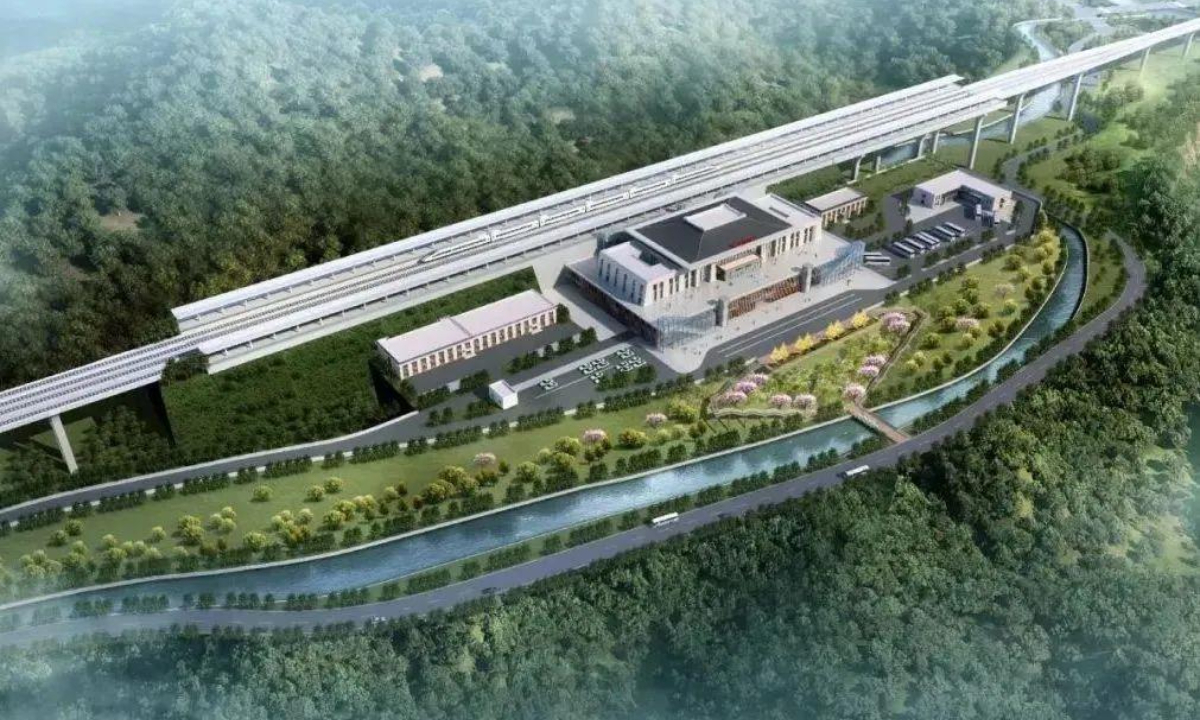
A screenshot of a rendering image of the Zhen'an West Station in Zhen'an county in Northwest China's Shaanxi Province Photo: China Media Group
Two Chinese high-speed railways with trains that will run at 350 kilometers (km) per hour are making important progress in construction.
The
mk main structure of the first station on the Xi'an-Ankang High-Speed Railway has been completed, and the Xi'an-Shiyan High-Speed Railway has achieved phased progress with the breakthrough of the Tianzhushan No.2 tunnel in Shanyang county, Northwest China's Shaanxi Province, China Media Group reported on Sunday.
The main structure of the Zhen'an West Station's building in Zhen'an county, Shaanxi was recently completed, making it the first station on the Xi'an-Ankang High-Speed Railway to finish the main structure's construction. The station has two platforms and four tracks, and its main building covers about 4,000 square meters.
The main line for the Xi'an-Ankang High-Speed Railway spans 171 kilometers. The route is an important component of the Beijing-Kunming Corridor and Baotou (Yinchuan)-Haikou Corridor, parts of China's high-speed rail network, which consists of eight vertical lines linking the country's north and south and eight horizontal lines connecting the east and west.
After the completion of the railway, the travel time between Xi'an and Ankang in Shaanxi will be shortened from three hours to less than one hour, which will play a vital role in supporting rural revitalization and promoting the economic and social development of the surrounding areas.
On January 9, the 4,118-meter-long Tianzhushan No.2 tunnel on the Xi'an-Shiyan High-Speed Railway was successfully completed. Facing challenges and difficulties in the building of the tunnel, advanced information technology and machinery were used to enhance the efficiency of advancement.
The Xi'an-Shiyan High-Speed Railway features a new 256-kilometer main line. The travel time from Xi'an to Shiyan in Central China's Hubei Province will be reduced to less than one hour, and the fastest travel time from Xi'an to Wuhan in Hubei Province will be cut in half to 2.5 hours.
The opening of the route will link Shaanxi with the Yangtze River Delta and the Pearl River Delta, and enhance connectivity among the Guanzhong cluster of cities and the middle Yangtze River region. The closer connections will have significant meaning in promoting the economy of central China, while assisting the high-quality development of the Yangtze River Economic Belt.
A new high-speed railway began operation on December 26, enhancing the rail network connecting major cities in East China's Yangtze River Delta Region, a major economic powerhouse, the Xinhua News Agency reported. With a designed speed of 350 km per hour and eight stations, the Shanghai-Suzhou-Huzhou High-Speed Railway, spanning 164 km, links Shanghai Hongqiao Station with Suzhou in East China's Jiangsu Province and Huzhou in Zhejiang Province.
Sun Zhang, a railway expert at Shanghai Tongji University, said that major tasks for planning and operating high-speed railways at the moment are to strengthen weaknesses and adjust the structure, such as further elevating the operating efficiency in regions with high demand while enhancing the speed for routes in the central and western regions.
Sun told the Global Times on Sunday that the opening of the Shanghai-Suzhou-Huzhou High-Speed Railway is a typical example of addressing the shortcomings of lacking sufficient capacity for regions with high demand, especially in more economically developed areas.
He highlighted the importance of reducing regional disparities by raising the speed for high-speed railways to 350 km per hour, represented by the two high-speed railways starting in Xi'an. A speed of 350 km per hour is common for routes in relatively developed regions, and the operating speed for some lines is about to rise to 400 km in the future, according to Sun.
A prototype of the CR450 bullet train that will run at 400 km per hour debuted in Beijing in December. The CR450 is capable of running at 450 km per hour in tests, according to another Xinhua report.

